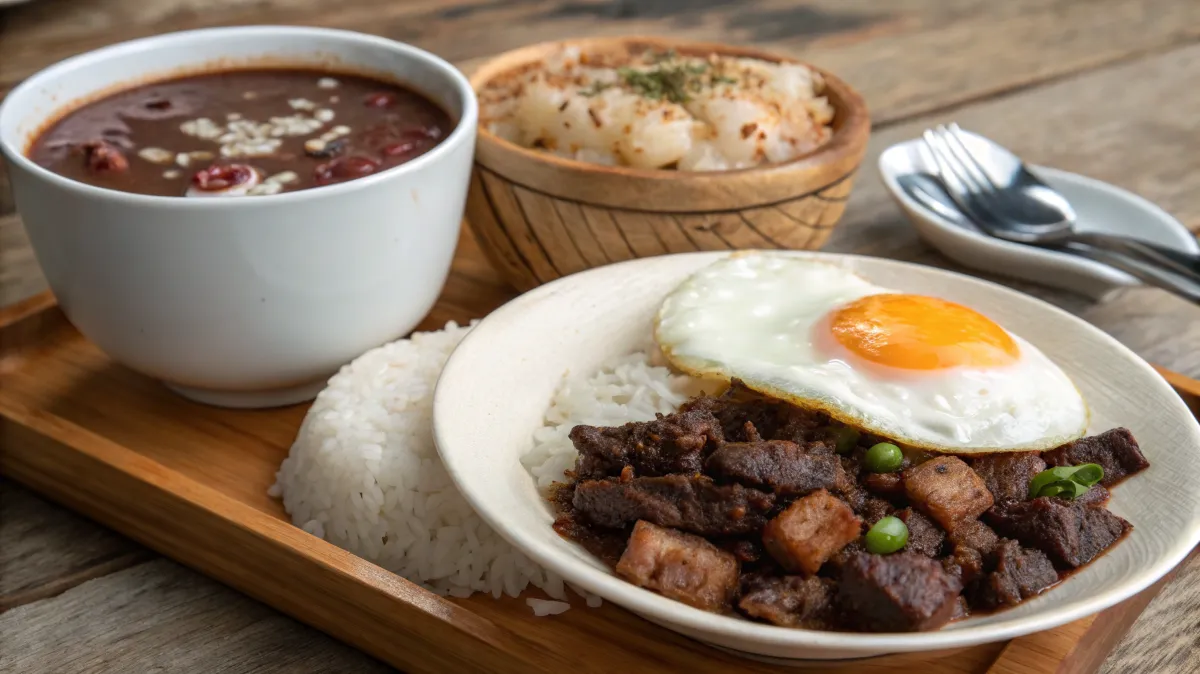Filipino breakfast, or almusal, is an essential part of the country’s culture, blending indigenous flavors with influences from Spanish, Chinese, and American cuisines. If you’re searching for healthy Filipino breakfast recipes that celebrate these rich roots, you’re in for a flavorful start to your day. From the beloved silog meals featuring garlic fried rice, eggs, and cured meats to comforting bowls of champorado, lugaw, and taho, Filipino breakfasts offer a hearty and satisfying start to the day.
In this article, we’ll explore:
- The origins and cultural influences of Pinoy breakfast.
- The most popular dishes and their variations.
- Easy recipes you can try at home.
- How Filipino breakfast compares to other Southeast Asian morning meals.
- Health benefits and nutritional value of common breakfast choices.
Whether you’re a Filipino looking to reconnect with traditional flavors or a food enthusiast eager to try something new, this guide will give you everything you need to know about Pinoy breakfast.
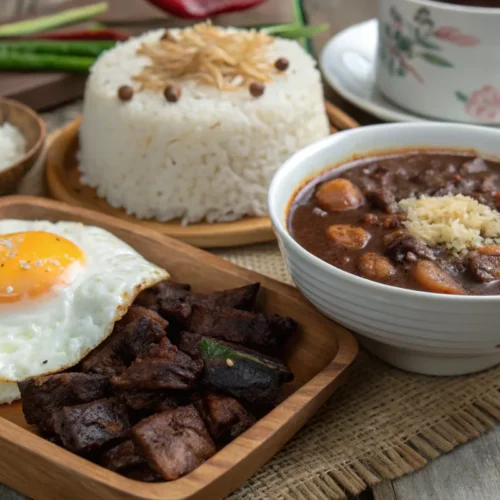
Classic Tapsilog (Filipino Beef Tapa with Garlic Rice and Fried Egg)
Equipment
- To prepare Tapsilog, you’ll need the following kitchen tools:
- Mixing bowl – For marinating the tapa (beef).
- Cutting board & knife – To slice the beef into thin pieces.
- Measuring cups & spoons – For accurate ingredient portions.
- Non-stick frying pan or skillet – For cooking the tapa and frying the eggs.
- Spatula – For stirring the garlic rice and flipping the beef.
- Rice cooker or pot – To cook fresh rice if you don’t have day-old rice.
- Serving plates – For plating the meal attractively.
- SEO Keywords for Tapsilog Recipe
Ingredients
- For the Tapa Cured Beef:
- ½ kg beef sirloin thinly sliced
- ¼ cup soy sauce
- 2 tbsp calamansi juice or lemon juice
- 1 tbsp brown sugar
- 4 cloves garlic minced
- ½ tsp black pepper
- 1 tbsp cooking oil
- For Sinangag Garlic Fried Rice:
- 3 cups cooked rice preferably day-old
- 5 cloves garlic minced
- 2 tbsp cooking oil
- ½ tsp salt
- For Itlog Fried Egg:
- 2 eggs
- 1 tbsp cooking oil
- Salt to taste
Instructions
- Marinate the Tapa – In a bowl, mix soy sauce, calamansi juice, sugar, garlic, and black pepper. Add the sliced beef and marinate for at least 4 hours or overnight in the refrigerator.
- Cook the Tapa – Heat 1 tbsp of oil in a pan over medium heat. Pan-fry the beef for 3-5 minutes per side, or until caramelized. Set aside.
- Prepare the Garlic Rice – In the same pan, heat 2 tbsp of oil and sauté garlic until golden brown. Add cooked rice and stir-fry for 5 minutes. Season with salt.
- Fry the Eggs – In another pan, heat 1 tbsp of oil and fry eggs sunny-side-up (or as preferred). Sprinkle with salt.
- Assemble and Serve – Plate the garlic rice, tapa, and fried egg together. Serve with atchara or spiced vinegar on the side.
Notes
If you prefer a sweeter tapa, add an extra ½ tbsp of sugar.
Store leftover tapa in an airtight container in the fridge for up to 3 days or freeze for up to 1 month.
The Essence of a Traditional Pinoy Breakfast
The Cultural and Historical Roots of Filipino Breakfast
Filipino breakfast is deeply influenced by history, geography, and foreign cultures and many of these traditions can inspire today’s healthy Filipino breakfast recipes that are both flavorful and balanced. Here’s how it evolved:
- Pre-colonial Era: Ancient Filipinos started their day with rice, root crops (like cassava and sweet potato), and fish.
- Spanish Influence: Introduced bread (pandesal), chocolate drinks, and cured meats like tapa and longganisa.
- Chinese Influence: Brought rice porridge (lugaw, goto, and arroz caldo) and soy-based snacks like taho.
- American Influence: Popularized coffee, canned meats (Spam, corned beef), and breakfast cereals.
- Check out Carol Tasty’s guide on Asian Breakfasts for more morning meal inspiration!
Essential Ingredients in a Filipino Breakfast
A traditional Pinoy breakfast revolves around these key ingredients:
| Ingredient | Description & Common Uses |
|---|---|
| Rice | Steamed rice or sinangag (garlic fried rice) as the meal’s base. |
| Eggs | Served sunny-side-up, scrambled, or as itlog maalat (salted egg). |
| Meats | Tapa (cured beef), longganisa (Filipino sausage). |
| Bread | Pandesal (soft bread rolls), ensaymada (sweet bread with cheese and butter). |
| Fruits | Mangoes, bananas, and coconut are common breakfast fruits. |
| Soups & Porridges | Lugaw, champorado (chocolate rice porridge), arroz caldo (chicken rice porridge). |
| Beverages | Kapeng Barako (strong coffee), salabat (ginger tea), and milo (chocolate drink). |
Popular Pinoy Breakfast Dishes
Silog Meals: The Ultimate Filipino Breakfast
One of the most iconic Filipino breakfast meals is the silog combination simple to prepare and easy to adjust into healthy Filipino breakfast recipes by grilling the protein or switching to brown rice. The term silog comes from sinangag (garlic fried rice) and itlog (egg), paired with a protein. Here are the most popular silog variations:
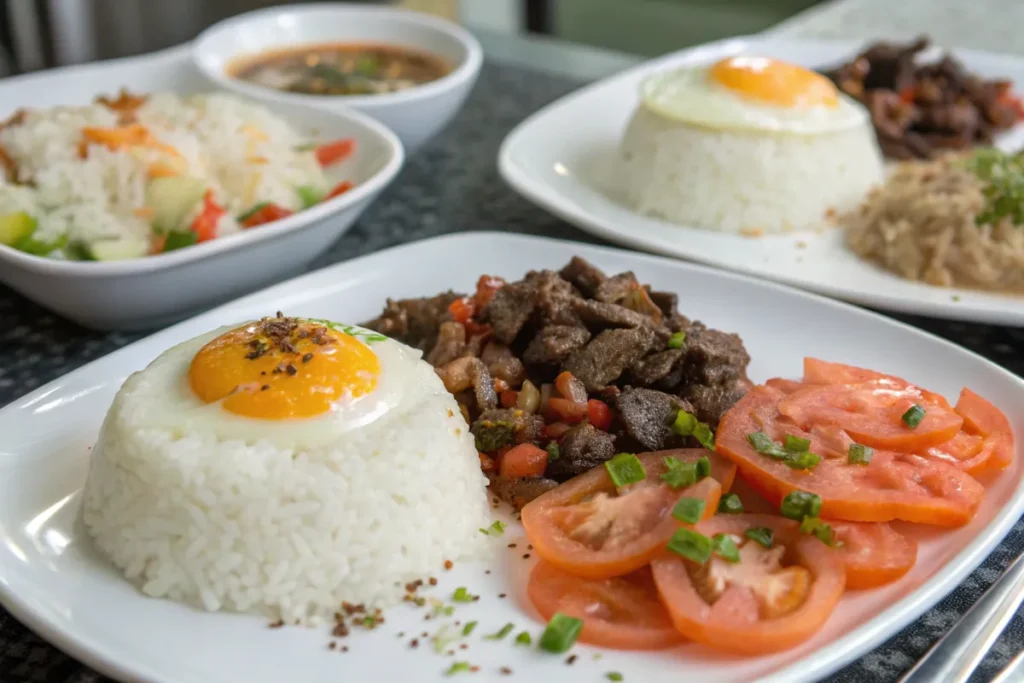
| Silog Meal | Main Protein | Description |
|---|---|---|
| Tapsilog | Tapa (cured beef) | Beef marinated in soy sauce, garlic, and calamansi, then pan-fried. |
| Tocilog | Tocino (sweet pork) | Pork slices cured in a sweet and savory marinade. |
| Longsilog | Longganisa (Filipino sausage) | A garlicky, sweet, or vinegar-laced sausage, depending on the region. |
| Bangsilog | Bangus (milkfish) | Fried or grilled marinated milkfish. |
| Hotsilog | Hotdog | A budget-friendly breakfast using Filipino-style red hotdogs. |
| Cornsilog | Corned Beef | Sautéed corned beef with onions, served with rice and egg. |
Sweet Filipino Breakfast Options
Not all Filipino breakfasts are savory. Several healthy Filipino breakfast recipes include sweet options like champorado made with oats or dark chocolate, reducing the sugar without losing the comfort. Many traditional morning meals cater to those with a sweet tooth:
- Champorado – A warm, comforting chocolate rice porridge made with sticky rice and tablea (pure cacao).
- Puto Bumbong – A Christmas delicacy made from purple sticky rice, steamed in bamboo tubes, and topped with coconut and muscovado sugar.
- Bibingka – A rice cake cooked in banana leaves, topped with salted eggs and cheese.
- Kakanin – Sticky rice cakes like sapin-sapin, biko, and palitaw, often paired with coffee.
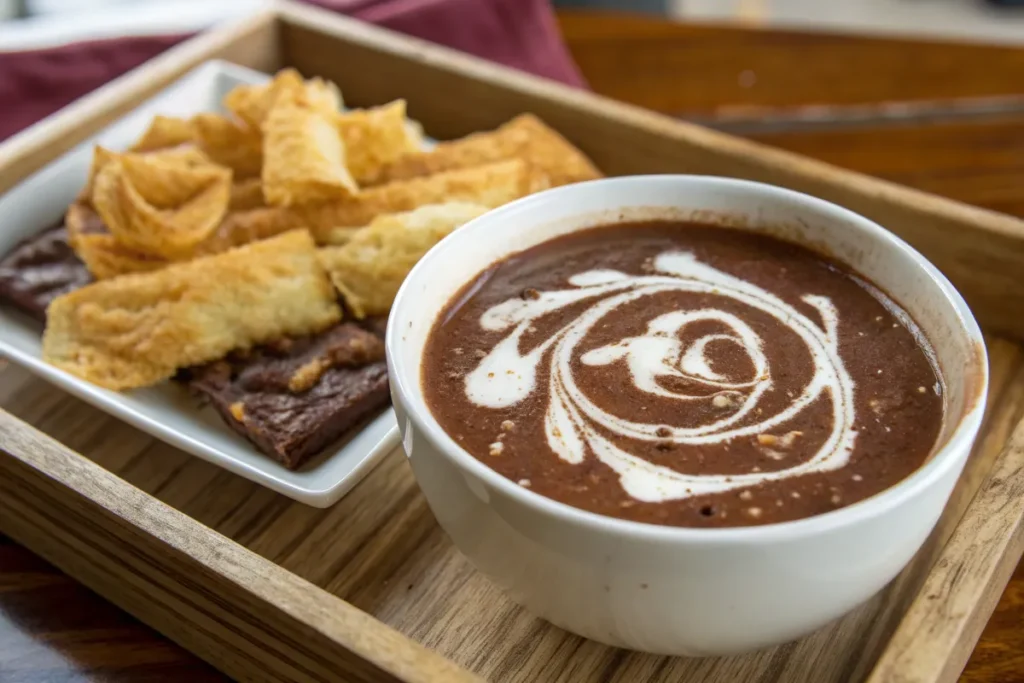
Quick and Simple Filipino Breakfasts
For those on the go, these quick and easy Filipino breakfasts are commonly enjoyed:
- Pandesal with Coffee – Soft bread rolls served with butter, cheese, or peanut butter, best paired with kapeng barako.
- Taho – A popular street food consisting of warm silken tofu, arnibal (caramel syrup), and sago pearls.
- Lugaw, Goto, and Arroz Caldo – Rice porridge variations served with boiled eggs, chicken, or beef tripe.
These easy, fuss-free meals are the backbone of many easy Filipino breakfast recipes that suit busy mornings without sacrificing cultural flavor.
Comparing Filipino Breakfast with Other Southeast Asian Breakfasts
How Filipino Breakfast Differs from Other Asian Morning Meals
Filipino breakfast shares similarities with other Southeast Asian cuisines but also has distinct characteristics. Below is a comparison of Filipino breakfast with Malaysian and Thai morning meals.
| Feature | Filipino Breakfast | Malaysian Breakfast | Thai Breakfast |
|---|---|---|---|
| Base | Rice-based (silog, champorado) | Rice or noodles (nasi lemak, roti canai) | Rice soup (khao tom), congee |
| Sweet Options | Champorado, bibingka, puto bumbong | Kaya toast, sweet porridge | Sticky rice with mango |
| Meat Choices | Tapa, tocino, longganisa, bangus | Chicken, beef, fish, sambal anchovies | Grilled pork, fish, chicken |
| Common Beverages | Kapeng Barako, Milo, Taho | Teh Tarik, Kopi-O | Thai iced tea, coffee |
Filipino vs. Western Breakfast
Western breakfasts are vastly different from Filipino breakfasts in terms of composition and portion size:
| Feature | Filipino Breakfast | Western Breakfast |
|---|---|---|
| Staple | Rice-based (sinangag, champorado) | Bread-based (toast, pancakes) |
| Protein Source | Tapa, longganisa, tocino, bangus | Bacon, sausage, eggs |
| Sweet Options | Champorado, bibingka, puto bumbong | Cereal, muffins, waffles |
| Drinks | Kapeng Barako, salabat, taho | Coffee, orange juice, tea |
Learn more about What is a Traditional Breakfast? – Compare Filipino breakfasts with other cultures.
Easy Pinoy Breakfast Recipes
How to Make Classic Tapsilog
Tapsilog, one of the most popular Filipino breakfast meals, is a combination of tapa (cured beef), sinangag (garlic fried rice), and itlog (fried egg). Here’s how to prepare it at home.
Among the most beloved healthy Filipino breakfast recipes, tapsilog stands out because it’s customizable and easy to cook using lean meats and less oil.
Ingredients
For the Tapa:
- ½ kg beef sirloin, thinly sliced
- ¼ cup soy sauce
- 2 tbsp calamansi juice (or lemon juice)
- 1 tbsp brown sugar
- 4 cloves garlic, minced
- ½ tsp black pepper
- 1 tbsp cooking oil
For Sinangag (Garlic Rice):
- 3 cups cooked rice (preferably day-old)
- 5 cloves garlic, minced
- 2 tbsp cooking oil
- ½ tsp salt
For Itlog (Fried Egg):
- 2 eggs
- 1 tbsp cooking oil
- Salt to taste
Instructions
- Marinate the Tapa – In a bowl, combine soy sauce, calamansi juice, sugar, garlic, and pepper. Add the beef and marinate for at least 4 hours or overnight.
- Cook the Tapa – Heat oil in a pan over medium heat. Cook the marinated beef for 3-5 minutes on each side until brown and slightly caramelized.
- Prepare the Garlic Rice – In a pan, heat oil and sauté garlic until golden brown. Add the rice and stir-fry for 5 minutes. Season with salt.
- Fry the Egg – Heat oil in a pan and cook eggs sunny-side-up or to your preference.
- Assemble and Serve – Plate the tapa with garlic rice and fried egg. Serve with atchara (pickled papaya) or vinegar on the side.
Quick and Easy Pandesal with Butter
Pandesal is a Filipino bread roll that pairs well with coffee or hot chocolate. While it’s traditionally baked fresh, you can make a quick version using store-bought bread.
Ingredients
- 6 pieces pandesal
- 2 tbsp butter or margarine
- 1 tbsp sugar (optional)
- Cheese or peanut butter (optional)
Instructions
- Slice the pandesal in half.
- Spread butter or margarine on each piece.
- Toast lightly in an oven or pan for 3-5 minutes until warm and slightly crisp.
- Sprinkle with sugar or add cheese for extra flavor.
How to Make Champorado (Filipino Chocolate Rice Porridge)
Champorado is a sweet chocolate rice porridge often enjoyed for breakfast, especially during rainy days.
Ingredients
- 1 cup glutinous rice (malagkit)
- 4 cups water
- ½ cup tablea (Filipino chocolate) or cocoa powder
- ½ cup sugar
- ½ cup evaporated milk
Instructions
- In a pot, bring water to a boil. Add glutinous rice and stir occasionally to prevent sticking.
- Once the rice softens (about 10 minutes), add tablea or cocoa powder. Stir until dissolved.
- Add sugar and continue stirring until the mixture thickens.
- Pour into bowls and drizzle with evaporated milk before serving.
For a healthier twist on this comfort dish, try oat-based champorado a great option when building your collection of healthy Filipino breakfast recipes at home.
Don’t miss our Breakfast Sandwich Sauce Guide – Great for pairing with pandesal or Filipino-style breakfast sandwiches.
Health Benefits and Nutritional Value of Filipino Breakfasts
A well-balanced Pinoy breakfast provides essential nutrients to fuel the day. While traditional Filipino breakfast dishes are flavorful and filling, it’s important to understand their nutritional value and how to make healthier choices.
Macronutrients in a Typical Filipino Breakfast
Understanding the components of a typical Filipino meal is key to developing nutritious Filipino breakfast options that still honor tradition.
| Component | Common Sources | Health Benefits |
|---|---|---|
| Carbohydrates | Rice (sinangag, lugaw, champorado), pandesal, kakanin | Provides energy for daily activities. |
| Proteins | Tapa, longganisa, tocino, eggs, bangus | Supports muscle growth and repair. |
| Fats | Coconut milk (bibingka, champorado), butter, cooking oil | Aids in brain function and energy storage. |
| Fiber | Fruits (mango, banana), vegetables, whole grains | Improves digestion and gut health. |
| Vitamins & Minerals | Eggs, milk, vegetables, seafood | Strengthens the immune system and bones. |
Healthier Alternatives for a Nutritious Pinoy Breakfast
While silog meals and fried dishes are delicious, some modifications can make them healthier:
| Traditional Version | Healthier Alternative |
|---|---|
| White rice (sinangag) | Brown rice or quinoa |
| Fried tapa or tocino | Grilled or air-fried meat |
| Meat longganisa | Chicken or vegetarian longganisa |
| Sweetened champorado | Use dark chocolate and reduce sugar |
| Pandesal with margarine | Whole wheat pandesal with peanut butter |
Best Filipino Breakfasts for Weight Loss
If you’re trying to maintain or lose weight, consider these breakfast choices:
- Oats Champorado – Substitute rice with oats for a fiber-rich version.
- Bangsilog with Brown Rice – Milkfish is rich in Omega-3 and healthier than processed meats.
- Vegetable Omelet with Whole Wheat Pandesal – A protein-packed option with added fiber.
- Lugaw with Lean Chicken and Malunggay – A light, nutrient-dense meal.
These are some of the best low calorie Filipino breakfast options you can prepare with minimal effort and maximum flavor.
The Best Places to Eat Traditional Filipino Breakfasts
Filipino breakfast is widely available throughout the Philippines, from street-side carinderias (local eateries) to high-end restaurants. Whether you’re looking for an authentic silog meal or a unique take on traditional dishes, here are some of the best places to enjoy a classic Pinoy breakfast.
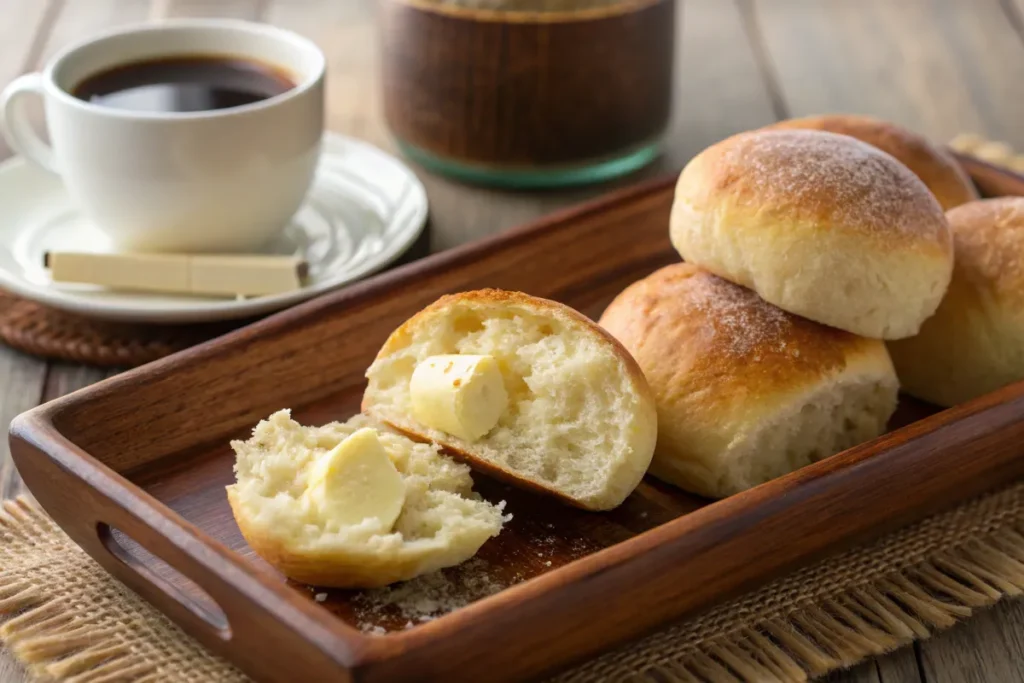
Famous Restaurants Serving Traditional Filipino Breakfast
| Restaurant | Location | Specialty Breakfast Dishes |
|---|---|---|
| Tapa King | Nationwide | Tapsilog, Tocilog, Cornsilog |
| Rico’s Lechon | Cebu & Manila | Lechon-silog (roast pig with rice and egg) |
| Rodic’s Diner | Quezon City | Famous for their shredded tapa |
| Kanto Freestyle Breakfast | Metro Manila | Gourmet-style silog meals and champorado |
| Lola Idang’s Pancit Malabon | Various locations | Pancit and native kakanin (bibingka, puto) |
Local Markets and Carinderias
For the most authentic home-cooked Filipino breakfasts, visit these local spots:
- Aling Banang’s (Manila) – A well-loved carinderia serving affordable silog meals.
- Baguio Public Market – Try fresh strawberries with taho and warm bibingka.
- Silog Express (Cebu) – A go-to spot for budget-friendly silog meals.
Filipino Breakfast Buffets
Some hotels and resorts offer extensive breakfast spreads featuring Filipino favorites:
- Spiral at Sofitel Manila – A luxury breakfast buffet featuring international and Filipino dishes.
- Vikings Luxury Buffet – Unlimited servings of tapa, longganisa, and native kakanin.
- Café Ilang-Ilang (Manila Hotel) – A great spot for traditional Filipino breakfast paired with local coffee.
FAQs About Pinoy Breakfast
What is a typical Filipino breakfast?
A typical Filipino breakfast consists of a silog meal, which includes sinangag (garlic fried rice), itlog (fried egg), and a protein like tapa (beef), longganisa (sausage), tocino (sweet pork), or bangus (milkfish). Other common breakfast dishes include pandesal with coffee, champorado (chocolate rice porridge), and taho (sweet silken tofu with syrup and sago pearls).
What is breakfast in Filipino?
Breakfast in Filipino is called “almusal” or “agahan”. The word “almusal” is derived from the Spanish word “almorzar,” which means to have breakfast.
What is Malaysia’s national breakfast?
Malaysia’s national breakfast is Nasi Lemak, a dish consisting of coconut rice, sambal (spicy chili paste), fried anchovies, boiled eggs, and cucumber slices, often served with chicken or beef rendang. Unlike Filipino breakfast, which is often meat-heavy and paired with eggs, Nasi Lemak has a strong balance of flavors—sweet, savory, and spicy.
What is a Filipino breakfast called?
Filipino breakfast does not have a single name but is commonly referred to as “almusal” or “silog” meals when referring to dishes served with garlic rice and eggs.
Conclusion
Filipino breakfast, or almusal, is a reflection of the country’s rich history and culinary diversity. With thoughtful ingredients and simple techniques, creating healthy Filipino breakfast recipes at home becomes an easy and rewarding part of your routine.. From hearty silog meals to comforting bowls of champorado and lugaw, Filipino mornings are filled with bold flavors, warm textures, and a deep sense of tradition. Whether you prefer a sweet start with bibingka or a savory silog paired with kapeng barako, there’s always something delicious to enjoy.
This guide has explored:
The origins and cultural significance of Filipino breakfast.
The most popular dishes and their variations.
Easy recipes to bring Pinoy breakfast to your home.
A comparison with other Southeast Asian breakfasts.
Where to find the best Filipino breakfast spots.
Table of Contents
No matter where you are in the world, a Filipino breakfast is a great way to experience the warmth and hospitality of Filipino culture—one meal at a time.
Check out Savory Breakfast Muffins Recipes – A unique alternative to traditional Filipino breakfasts.

